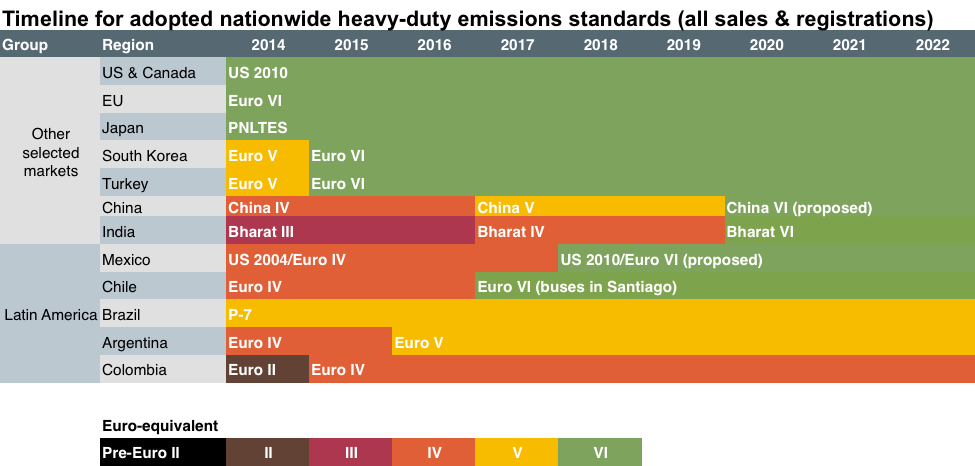Cost-benefit analysis of Brazil's heavy-duty emission standards (P-8)
Blog
Euro VI for Brazil: A clear path for cleaner skies
In early February, CETESB, São Paulo’s Environmental Agency, announced new phases for Brazil’s vehicle emission standards, starting with heavy-duty vehicles (HDVs) in 2019 and motorcycles in 2020. Standards for light-duty vehicles (LDVs) will be implemented progressively in different phases up to the final phase in 2026. Technical details were not made public when the schedule for phasing in the new regulations was announced. This is an opportune moment, then, to highlight the significant benefits that will accrue to Brazil if the new standards for HDVs align as closely as possible with the European Union’s Euro VI standard.
Many cities in Brazil do not comply with the air quality guidelines recommended by the World Health Organization, so further action is necessary to improve air quality and protect public health. HDVs—trucks and buses—represent an effective target for early emission control. Although HDVs represent less than 5% of the total on-road fleet in Brazil, HDVs contribute to 90% of emissions of harmful pollutants from all on-road vehicles.
Brazil’s HDV emission standards already follow the European pathway. Brazil’s HDVs have complied with P-7 standards, which are Euro V-equivalent, since 2012, and thus Euro VI standards are the natural next step. Euro VI standards (and their counterparts in Canada, Japan, South Korea, and the United States) are the most stringent and effective HDV standards ever implemented. They include lower emission limits than previous standards and a new limit for particle number. Euro VI standards also guarantee in-use compliance beyond the laboratory tests through more representative test cycles, cold-start requirements, more robust on-board diagnostics (OBD), better durability requirements, and in-use testing.
These details matter. Brazil should adopt Euro VI in its entirety, because deviations could have unintended consequences. Euro V vehicles have struggled to meet emission limits in the real world in many markets because test cycles do not adequately represent normal driving conditions, especially in urban areas. This means that automakers designed trucks and buses to pass certification tests, but not necessarily to comply with emission limits in the real world. In Brazil, the problem with P-7 vehicles was worse. Although Euro V vehicles are supposed to lose power and eventually stop if adequate urea (sold as ARLA-32 in Brazil) is not used, P-7 trucks failed to do so and enabled drivers to operate without adequate ARLA-32. Adopting Euro VI standards with as little deviation as possible would minimize the risk of such compliance issues.
If well implemented, advancing to Euro VI-equivalent standards in Brazil would fix the urea/ARLA-32 non-compliance problem, ensure that vehicles are performing adequately under normal driving conditions, and most importantly, improve air quality—aligning with Euro VI would result in a 90% reduction in emissions from NOx and PM in comparison to the latest technology produced locally (P-7/Euro V).
Euro VI-equivalent standards in Brazil would also be cost effective. The costs associated with advanced emission controls would increase by less than 2%, and the economic benefits associated with fewer premature deaths outweigh technology costs by a ratio of 11 to 1. Euro VI-equivalent standards in Brazil would prevent ~74,000 deaths and generate a net economic benefit of $67 billion over 30 years (assuming implementation in 2018). It is hard to imagine another public policy with a better return on investment from a societal point of view.
In addition, the production of cleaner truck and bus technology would increase Brazil’s industry competitiveness. Until the implementation of current P-7 standards in 2012, Brazil had consistently adopted clean vehicle standards before other developing countries. Since then, Brazil has fallen behind Mexico, China, and India, all of which have proposed or adopted their new phases equivalent to Euro VI standards (see chart). Santiago, Mexico City, and Istanbul have also announced their commitment to Euro VI-equivalent urban buses, and more cities are likely to follow. Advancing to the latest HDV emission standards in Brazil would also increase access to soot-free engine technology throughout Latin America. This is particularly important in countries such as Argentina, Chile, Colombia, Mexico, and Peru, which are not major producers of HDV engines and thus follow Brazil’s timeline by default.
Brazil has already laid the foundation for Euro VI-equivalent standards. To function properly, Euro VI emission-control systems require low-sulfur diesel (10 ppm or less) and urea/ARLA-32, both of which are already available in Brazil because they are also required for P-7/Euro V vehicles. ARLA-32 is currently sold nationwide, and 10-ppm diesel is sold in major cities and select stations outside major cities, to supply P-7 vehicles. To ensure the proper operation and avoid misfueling of P-7 and more advanced vehicles in the long run, 500-ppm diesel should be phased out of regions outside major metropolitan areas. The 2019 implementation timeline for the new HDV standards is appropriate and realistic given that Brazil is already at Euro V and has access to both 10ppm diesel and ARLA-32. Maintaining this timeline is crucial: Assuming the new standards are equivalent to Euro VI standards, with each year of delay of implementation (i.e., 2020 instead of 2019), there would be an additional 2,500 premature deaths.
About half of all HDVs sold worldwide already meet the Euro VI standards, so we are not talking about cutting edge technology. The headquarters of all automakers in Brazil are already producing Euro VI vehicles for developed markets, and advancing to Euro VI-equivalent vehicles in Brazil would close the gap between cleaner vehicles sold elsewhere and their dirtier cousins currently sold in Brazil. Many Brazilian lungs will be grateful.

